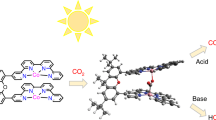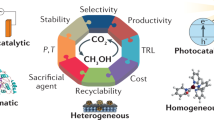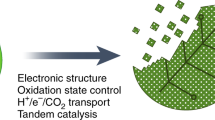Abstract
Increasing levels of CO2 in the atmosphere is a problem that must be urgently resolved if the rise in current global temperatures is to be slowed. Chemically reducing CO2 into compounds that are useful as energy sources and carbon-based materials could be helpful in this regard. However, for the CO2 reduction reaction (CO2RR) to be operational on a global scale, the catalyst system must: use only renewable energy, be built from abundantly available elements and not require high-energy reactants. Although light is an attractive renewable energy source, most existing CO2RR methods use electricity and many of the catalysts used are based on rare heavy metals. Here we present a transition-metal-free catalyst system that uses an organohydride catalyst based on benzimidazoline for the CO2RR that can be regenerated using a carbazole photosensitizer and visible light. The system is capable of producing formate with a turnover number exceeding 8,000 and generates no other reduced products (such as H2 and CO).

This is a preview of subscription content, access via your institution
Access options
Access Nature and 54 other Nature Portfolio journals
Get Nature+, our best-value online-access subscription
$29.99 / 30 days
cancel any time
Subscribe to this journal
Receive 12 print issues and online access
$259.00 per year
only $21.58 per issue
Buy this article
- Purchase on Springer Link
- Instant access to full article PDF
Prices may be subject to local taxes which are calculated during checkout






Similar content being viewed by others
Data availability
The additional discussions and the data supporting the plots within this Article and other findings of this study, such as 1H NMR and 13C NMR spectra, cyclic voltammograms, optical spectra, experimental procedures, and quantum chemical calculations, are available in the Supplementary Information. Source data are provided with this Article.
References
White, J. L. et al. Light-driven heterogeneous reduction of carbon dioxide: photocatalysts and photoelectrodes. Chem. Rev. 115, 12888–12935 (2015).
MacDowell, N. et al. An overview of CO2 capture technologies. Energy Environ. Sci. 3, 1645–1669 (2010).
Aresta, M., Dibenedetto, A. & Angelini, A. Catalysis for the valorization of exhaust carbon: from CO2 to chemicals, materials, and fuels. Technological use of CO2. Chem. Rev. 114, 1709–1742 (2014).
Ra, E. C. et al. Recycling carbon dioxide through catalytic hydrogenation: recent key developments and perspectives. ACS Catal. 10, 11318–11345 (2020).
Qiao, J., Liu, Y., Hong, F. & Zhang, J. A review of catalysts for the electroreduction of carbon dioxide to produce low-carbon fuels. Chem. Soc. Rev. 43, 631–675 (2014).
Takeda, H., Cometto, C., Ishitani, O. & Robert, M. Electrons, photons, protons and earth-abundant metal complexes for molecular catalysis of CO2 reduction. ACS Catal. 7, 70–88 (2017).
Seyferth, D. The Grignard reagents. Organometallics 28, 1598–1605 (2009).
Seo, H., Liu, A. & Jamison, T. F. Direct β-selective hydrocarboxylation of styrenes with CO2 enabled by continuous flow photoredox catalysis. J. Am. Chem. Soc. 139, 13969–13972 (2017).
Seo, H., Katcher, M. H. & Jamison, T. F. Photoredox activation of carbon dioxide for amino acid synthesis in continuous flow. Nat. Chem. 9, 453–456 (2017).
Matsuoka, S., Kohzuki, T., Pac, C. & Yanagida, S. Photochemical reduction of carbon dioxide to formate catalyzed by p-terphenyl in aprotic polar solvent. Chem. Lett. 19, 2047–2048 (1990).
Sun, Z. et al. Catalysis of carbon dioxide photoreduction on nanosheets: fundamentals and challenges. Angew. Chem. Int. Ed. 57, 7610–7627 (2018).
Matsuoka, S., Yamamoto, K., Pac, C. & Yanagida, S. Enhanced p-terphenyl-catalyzed photoreduction of CO2 to CO through the mediation of Co(III)–cyclam complex. Chem. Lett. 20, 2099–2100 (1991).
Zhang, X., Cibian, M., Call, A., Yamauchi, K. & Sakai, K. Photochemical CO2 reduction driven by water-soluble copper(I) photosensitizer with the catalysis accelerated by multi-electron chargeable cobalt porphyrin. ACS Catal. 9, 11263–11273 (2019).
Tamaki, Y., Morimoto, T., Koike, K. & Ishitani, O. Photocatalytic CO2 reduction with high turnover frequency and selectivity of formic acid formation using Ru(II) multinuclear complexes. Proc. Natl Acad. Sci. USA 109, 15673–15678 (2012).
Lee, S. E. et al. Visible-light photocatalytic conversion of carbon dioxide by Ni(II) complexes with N4S2 coordination: Highly efficient and selective production of formate. J. Am. Chem. Soc. 142, 19142–19149 (2020).
Liu, X., Inagaki, S. & Gong, J. Heterogeneous molecular systems for photocatalytic CO2 reduction with water oxidation. Angew. Chem. Int. Ed. 55, 14924–14950 (2016).
Su, B., Cao, Z.-C. & Shi, Z.-J. Exploration of earth-abundant transition metals (Fe, Co, and Ni) as catalysts in unreactive chemical bond activations. Acc. Chem. Res. 48, 886–896 (2015).
Wang, D. & Astruc, D. The recent development of efficient earth-abundant transition-metal nanocatalysts. Chem. Soc. Rev. 46, 816–854 (2017).
Schneider, J., Jia, H., Muckerman, J. T. & Fujita, E. Thermodynamics and kinetics of CO2, CO, and H+ binding to the metal centre of CO2 reduction catalysts. Chem. Soc. Rev. 41, 2036–2051 (2012).
Behnke, S. L., Manesis, A. C. & Shafaat, H. S. Spectroelectrochemical investigations of nickel cyclam indicate different reaction mechanisms for electrocatalytic CO2 and H+ reduction. Dalton Trans. 47, 15206–15216 (2018).
Elgrishi, N., Chambers, M. B. & Fontecave, M. Turning it off! Disfavouring hydrogen evolution to enhance selectivity for CO production during homogeneous CO2 reduction by cobalt–terpyridine complexes. Chem. Sci. 6, 2522–2531 (2015).
Ooka, H., Figueiredo, M. C. & Koper, M. T. M. Competition between hydrogen evolution and carbon dioxide reduction on copper electrodes in mildly acidic media. Langmuir 33, 9307–9313 (2017).
An, P. et al. Enhancing CO2 reduction by suppressing hydrogen evolution with polytetrafluoroethylene protected copper nanoneedles. J. Mater. Chem. A 8, 15936–15941 (2020).
Tsujiguchi, T. et al. Acceleration of electrochemical CO2 reduction to formate at the Sn/reduced graphene oxide interface. ACS Catal. 11, 3310–3318 (2021).
Hietala, J. et al. in Ullmann’s Encyclopedia of Industrial Chemistry 7th edn (eds Bellussi, G. et al.) (Wiley, 2016); https://doi.org/10.1002/14356007.a12_013.pub3
Yang, J. Y., Kerr, T. A., Wang, X. S. & Barlow, J. M. Reducing CO2 to HCO2– at mild potentials: Lessons from formate dehydrogenase. J. Am. Chem. Soc. 142, 19438–19445 (2020).
Lorenzo, B. F. & O’Kiely, P. Alternatives to formic acid as a grass silage additive under two contrasting ensilability conditions. Irish J. Agr. Food Res. 47, 135–149 (2008).
Bahuguna, A. & Sasson, Y. Formate-bicarbonate cycle as a vehicle for hydrogen and energy storage. ChemSusChem 14, 1258–1283 (2021).
Enthaler, S. Carbon dioxide—the hydrogen-storage material of the future? ChemSusChem 1, 801–804 (2008).
Joó, F. Breakthroughs in hydrogen storage—formic acid as a sustainable storage material for hydrogen. ChemSusChem 1, 805–808 (2008).
Boston, D. J., Xu, C., Armstrong, D. W. & MacDonnell, F. M. Photochemical reduction of carbon dioxide to methanol and formate in a homogeneous system with pyridinium catalysts. J. Am. Chem. Soc. 135, 16252–16255 (2013).
Tamaki, Y., Koike, K. & Ishitani, O. Highly efficient, selective, and durable photocatalytic system for CO2 reduction to formic acid. Chem. Sci. 6, 7213–7221 (2015).
P, S. & Mandal, S. K. From CO2 activation to catalytic reduction: A metal-free approach. Chem. Sci. 11, 10571–10593 (2020).
Oh, Y. & Hu, X. Organic molecules as mediators and catalysts for photocatalytic and electrocatalytic CO2 reduction. Chem. Soc. Rev. 42, 2253–2261 (2013).
Lim, C.-H., Holder, A. M., Hynes, J. T. & Musgrave, C. B. Catalytic reduction of CO2 by renewable organohydrides. J. Phys. Chem. Lett. 6, 5078–5092 (2015).
Keith, J. A. & Carter, E. A. Theoretical insights into electrochemical CO2 reduction mechanisms catalyzed by surface-bound nitrogen heterocycles. J. Phys. Chem. Lett. 4, 4058–4063 (2013).
Alherz, A. et al. Renewable hydride donors for the catalytic reduction of CO2: a thermodynamic and kinetic study. J. Phys. Chem. B 122, 10179–10189 (2018).
Wen, F. et al. Amide-bridged conjugated organic polymers: efficient metal-free catalysts for visible-light-driven CO2 reduction with H2O to CO. Chem. Sci. 12, 11548–11553 (2021).
Wang, Y., Godin, R., Durrant, J. R. & Tang, J. Efficient hole trapping in carbon dot/oxygen-modified carbon nitride heterojunction photocatalysts for enhanced methanol production from CO2 under neutral conditions. Angew. Chem. Int. Ed. 60, 20811–20816 (2021).
Mazzanti, S. et al. All-organic Z-scheme photoreduction of CO2 with water as the donor of electrons and protons. Appl. Catal. B 285, 119773 (2021).
Courtemanche, M.-A., Légaré, M.-A., Maron, L. & Fontaine, F.-G. A highly active phosphine–borane organocatalyst for the reduction of CO2 to methanol using hydroboranes. J. Am. Chem. Soc. 135, 9326–9329 (2013).
Lim, C.-H. et al. Benzimidazoles as metal-free and recyclable hydrides for CO2 reduction to formate. J. Am. Chem. Soc. 141, 272–280 (2019).
Rueping, M., Dufour, J. & Schoepke, F. R. Advances in catalytic metal-free reductions: From bio-inspired concepts to applications in the organocatalytic synthesis of pharmaceuticals and natural products. Green Chem. 13, 1084–1105 (2011).
Lu, L.-Q., Li, Y., Junge, K. & Beller, M. Iron-catalyzed hydrogenation for the in situ regeneration of an NAD(P)H model: Biomimetic reduction of α-keto-/α-iminoesters. Angew. Chem. Int. Ed. 52, 8382–8386 (2013).
Chen, Q.-A. et al. Dihydrophenanthridine: a new and easily regenerable NAD(P)H model for biomimetic asymmetric hydrogenation. J. Am. Chem. Soc. 134, 2442–2448 (2012).
Chen, Q.-A. et al. Biomimetic asymmetric hydrogenation: in situ regenerable Hantzsch esters for asymmetric hydrogenation of benzoxazinones. J. Am. Chem. Soc. 133, 16432–16435 (2011).
Paul, C. E., Arends, I. W. C. E. & Hollmann, F. Is simpler better? Synthetic nicotinamide cofactor analogues for redox chemistry. ACS Catal. 4, 788–797 (2014).
Wu, H. et al. Methods for the regeneration of nicotinamide coenzymes. Green Chem. 15, 1773–1789 (2013).
Ohtsu, H. & Tanaka, K. An organic hydride transfer reaction of a ruthenium NAD model complex leading to carbon dioxide reduction. Angew. Chem. Int. Ed. 51, 9792–9795 (2012).
Emmanuel, M. A., Greenberg, N. R., Oblinsky, D. G. & Hyster, T. K. Accessing non-natural reactivity by irradiating nicotinamide-dependent enzymes with light. Nature 540, 414–417 (2016).
Wang, J., Zhu, Z.-H., Chen, M.-W., Chen, Q.-A. & Zhou, Y.-G. Catalytic biomimetic asymmetric reduction of alkenes and imines enabled by chiral and regenerable NAD(P)H models. Angew. Chem. Int. Ed. 58, 1813–1817 (2019).
Ohtsu, H. & Tanaka, K. Drastic difference in the photo-driven hydrogenation reactions of ruthenium complexes containing NAD model ligands. Chem. Commun. 48, 1796–1798 (2012).
Ma, B. et al. Efficient visible-light-driven CO2 reduction by a cobalt molecular catalyst covalently linked to mesoporous carbon nitride. J. Am. Chem. Soc. 142, 6188–6195 (2020).
Shon, J.-H. et al. Photoredox catalysis on unactivated substrates with strongly reducing iridium photosensitizers. Chem. Sci. 12, 4069–4078 (2021).
Hong, D., Tsukakoshi, Y., Kotani, H., Ishizuka, T. & Kojima, T. Visible-light-driven photocatalytic CO2 reduction by a Ni(II) complex bearing a bioinspired tetradentate ligand for selective CO production. J. Am. Chem. Soc. 139, 6538–6541 (2017).
Kamada, K. et al. Photocatalytic CO2 reduction using a robust multifunctional iridium complex toward the selective formation of formic acid. J. Am. Chem. Soc. 142, 10261–10266 (2020).
Hasegawa, E. et al. Photoinduced electron transfer reactions of α,β-epoxy ketones with 2-phenyl-N,N-dimethylbenzimidazoline (PDBMI): significant water effect on the reaction pathway. Tetrahedron Lett. 37, 7079–7082 (1996).
Ilic, S., Alherz, A., Musgrave, C. B. & Glusac, K. D. Importance of proton-coupled electron transfer in cathodic regeneration of organic hydrides. Chem. Commun. 55, 5583–5586 (2019).
Hasegawa, E. et al. Photoinduced electron-transfer systems consisting of electron-donating pyrenes or anthracenes and benzimidazolines for reductive transformation of carbonyl compounds. Tetrahedron 62, 6581–6588 (2006).
Matsubara, R. et al. UVA- and visible-light-mediated generation of carbon radicals from organochlorides using nonmetal photocatalyst. J. Org. Chem. 83, 9381–9390 (2018).
Yabuta, T., Hayashi, M. & Matsubara, R. Photocatalytic reductive C–O bond cleavage of alkyl aryl ethers by using carbazole catalysts with cesium carbonate. J. Org. Chem. 86, 2545–2555 (2021).
Pokharel, U. R., Fronczek, F. R. & Maverick, A. W. Retracted article: Reduction of carbon dioxide to oxalate by a binuclear copper complex. Nat. Commun. 5, 5883 (2014).
Khamespanah, F. et al. Oxalate production via oxidation of ascorbate rather than reduction of carbon dioxide. Nat. Commun. 12, 1997 (2021).
Pokharel, U. R., Fronczek, F. R. & Maverick, A. W. Retraction note: reduction of carbon dioxide to oxalate by a binuclear copper complex. Nat. Commun. 12, 1996 (2021).
Connelly, N. G. & Geiger, W. E. Chemical redox agents for organometallic chemistry. Chem. Rev. 96, 877–910 (1996).
Zhu, X.-Q., Mu, Y.-Y. & Li, X.-T. What are the differences between ascorbic acid and NADH as hydride and electron sources in vivo on thermodynamics, kinetics, and mechanism? J. Phys. Chem. B 115, 14794–14811 (2011).
Weerasooriya, R. B. et al. Kinetics of hydride transfer from catalytic metal-free hydride donors to CO2. J. Phys. Chem. Lett. 12, 2306–2311 (2021).
Macartney, D. H. & Sutin, N. The oxidation of ascorbic acid by tris(2,2'-bipyridine) complexes of osmium(III), ruthenium(III) and nickel(III) in aqueous media: Applications of the Marcus cross-relation. Inorg. Chim. Acta 74, 221–228 (1983).
Acknowledgements
R.M. is thankful for financial support from ENEOS TonenGeneral Research/Development Encouragement & Scholarship Foundation, Takahashi Industrial and Economic Research Foundation, the Takano Science Foundation, Kanamori Foundation, and Fukuoka Naohiko Memorial Foundation. This work was partially supported by JSPS KAKENHI Grant-in-Aid for Transformative Research Areas, “Dynamic Exciton” (JP20H05832 to Y.K.) and grant numbers JP20K21174, JP20KK0120 and JP22K19008 to Y.K. We thank T. Amimoto from the Natural Science Center for Basic Research and Development (N-BARD), Hiroshima University for mass analysis measurements. We also thank T. Tachikawa and Z. Zhang at Kobe University for their assistance on GC analysis and T. Harada at Kobe University for determining the mechanism elucidation hint.
Author information
Authors and Affiliations
Contributions
R.M. conceived and directed the project. R.M., W.X. and Y.K. wrote the paper. W.X., J.X. and U.M.I. performed most experiments under the supervision of R.M. and M.H. J.K., M.F. and Y.K. conducted transient absorption spectroscopy and fluorescence lifetime measurements. M.Y. conducted the computational calculation for the transition states. All authors discussed the results and commented on the manuscript.
Corresponding authors
Ethics declarations
Competing interests
The authors declare no competing interests.
Peer review
Peer review information
Nature Chemistry thanks Koji Tanaka and the other, anonymous, reviewer(s) for their contribution to the peer review of this work.
Additional information
Publisher’s note Springer Nature remains neutral with regard to jurisdictional claims in published maps and institutional affiliations.
Extended data
Extended Data Fig. 1 13C-labelling experiment.
a, A solution of 1 (1.5 mM), BI+(I−) (2.5 mM), H2A (50 mM), and NaOH (110 mM) was irradiated (λmax = 400 nm) for 20 h under 1 atm of 13CO2 atmosphere. According to 1H NMR analysis, 13C-formate was obtained in a yield of 45 mM, along with a small amount of 12C-formate. This confirmed that the carbon source of the product formate is gaseous CO2. b, 1H NMR spectrum of the reaction mixture. The formation of 13C-formate was characterized by a set of doublet peaks (9.06 and 8.58 ppm). The singlet peak at 6.57 ppm is 1,3,5-trimethoxybenzene (internal standard). c, Proton-decoupled 13C (13C{1H}) NMR spectrum of the reaction mixture. An intense peak attributed to 13C-formate was observed at 169.4 ppm.
Supplementary information
Supplementary Information
Supplementary Figs. 1–47, Sections 1–32 and Tables 1–15.
Source data
Source Data Fig. 4a
Numerical source data for spectroscopy and calculation.
Source Data Fig. 4b
Numerical source data for spectroscopy.
Source Data Fig. 4c
Numerical source data for spectroscopy.
Source Data Fig. 4d
Numerical source data for spectroscopy.
Rights and permissions
Springer Nature or its licensor (e.g. a society or other partner) holds exclusive rights to this article under a publishing agreement with the author(s) or other rightsholder(s); author self-archiving of the accepted manuscript version of this article is solely governed by the terms of such publishing agreement and applicable law.
About this article
Cite this article
Xie, W., Xu, J., Md Idros, U. et al. Metal-free reduction of CO2 to formate using a photochemical organohydride-catalyst recycling strategy. Nat. Chem. 15, 794–802 (2023). https://doi.org/10.1038/s41557-023-01157-6
Received:
Accepted:
Published:
Issue Date:
DOI: https://doi.org/10.1038/s41557-023-01157-6
This article is cited by
-
Elastomers mechanically reinforced and toughened with CO2 gas
Communications Materials (2024)
-
NAD(P)H inspired CO2 reduction and beyond
Science China Chemistry (2023)



